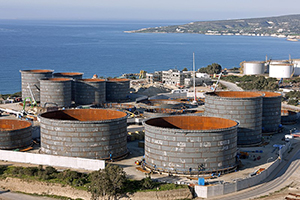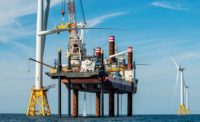
A new oil terminal being built by the Athens-based global contractor Joannou and Paraskevaides Ltd. for the world’s largest oil trader, the Vitol Group, is providing some hope to financially challenged Cyprus. The Mediterranean island is hoping a large energy investment will help to repay a $10-billion European Union loan intended to save the country from insolvency.
The Vitol terminal and other energy-sector projects are providing some optimism in a depressed economic environment. “There’s euphoria over the energy projects ongoing in Cyprus but also a gloom for the present situation,” says Constantinos Hadjistassou, an oil-and-gas industry analyst and researcher at the University of Cyprus.
“Because of the current financial difficulties, most Cypriots base their hopes on the many energy projects under development in Cyprus, with the Vitol terminal being one,” Hadjistassou says. “Cyprus has the third-largest barge fleet in terms of tonnage in the EU. We have a stable political system and a highly educated workforce, and Cyprus does feel confident that it can raise capital if these projects are viable.”
A precursor to the island's financial crisis was oil trading giant Trafigura’s relocation of its headquarters from Cyprus to Singapore last year. Oil trading has been a major cornerstone of the Cyprus economy, but many firms that have operated here have minimized their exposure to the country’s financial sector or simply left.
However, Vitol doubled down on its position in Cyprus. The Dutch-owned oil trader, with offices in Rotterdam and Geneva, Switzerland, committed to building the Vitol oil terminal at the southern port of Vasilikos in a joint venture with MISC Berhad, the shipping arm of Malaysian oil giant Petronas. The partners see Cyprus as a Mediterranean energy hub, connecting petroleum-product flows among Africa, Europe and the Middle East.
Foreign investment of €300 million in the project equals 1.7% of Cyprus’ gross domestic product, Vitol says. Joannou and Paraskevaides Ltd. (J&P) provided engineering, procurement and construction services for the tank farm. The design features 34 oil-storage tanks and one oily-water tank, with a total net capacity of 630,000 cubic meters. The project also includes a marine jetty, topsides and associated works at Vasilikos, with the overall construction valued at $260 million. It is expected to be completed in 2014.
Vitol says the facility will provide significant economic benefits as Cyprus energy consumption depends almost fully on imported refined-oil products, making the country one of the most vulnerable in the EU in terms of energy-supply security, the European Commission recently reported. “Cyprus imports all of its oil, as we have no indigenous refining or mining at present. The new oil terminal at Vasilikos will provide security of supply. We hope to have jetties in the water by this time next year,” says Solon Kassinis, executive vice president of the Cyprus state hydrocarbons company. “Our president has expressed the intention to turn Cyprus into a regional center for oil, so the Vitol terminal is very important.”
“An oil terminal is crucial for Cyprus to benefit from some of its own trading and create a destination for increased competition of oil products moving through Cyprus’ shores,” said the U.S. Energy Information Administration in April.
Four berths, which will handle all oil products with loading arms capable of handling 1,250 cu m an hour per product, will share infrastructure with other energy developments in the area and can achieve economies of scale by sharing Vasilikos’ port facilities and services.
The oil-product terminal will be a hub facility that caters to Aframax and Suezmax oil tankers with imports and the re-export of smaller tankers' oil products to Mediterranean countries. In the second phase of the project, the planned terminal includes a jetty for the importation of liquefied natural gas. The jetty structure will have 1,800-m-long access trestles to jetty heads, with four berths at 15-m to 20-m water depths. Each berth is equipped with breasting and mooring dolphins and a loading platform that has installations for oil-product handling and firefighting. Hiteco Engineering Ltd., Cyprus, provided front-end engineering and design services for the tank farm.
Niras Group, Denmark, provided ocean studies, 3D maneuvering simulation, design and tendering services after being awarded a tender contract from Vitol in 2011. “The access trestles to the berths are designed with a steel-girder superstructure with 45-meter spans supported by piled foundations with tubular-steel piles and reinforced-concrete capping beams,” Niras says. “The loading platforms are designed with [a reinforced-concrete] superstructure on tubular-steel piles.”
This effort is the beginning of a larger plan to transform Cyprus into a regional energy hub, a plan that includes the construction of a $6-billion liquefied natural gas (LNG) manufacturing facility and terminal at Vasilikos to process feedstock from the country's offshore territory, where large reserves have recently been discovered. If completed, the LNG facility also could incorporate natural gas from elsewhere in the eastern Mediterranean for processing and distribution. The Cyprus Energy Regulatory Authority says engineering and design for the facility are nearly complete, and investors are being sought. “We have been sending out proposals and expect final decisions soon,” Kassinis says.












Post a comment to this article
Report Abusive Comment